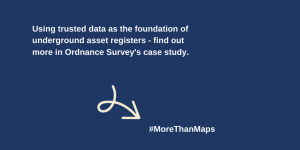Ordnance Survey
“Ordnance Survey was delighted to be a partner in this unique and ambitious project. The Geospatial Commission’s NUAR pilots have clearly demonstrated the value of bringing together multi-stakeholder data into a single register through which data can be shared and exchanged – delivering an immediate reduction in risk and a broader increase to efficiency. The importance of trusted geospatial data being at the foundation of the initiative has been widely recognised and builds on decades of valuable collaboration with the utility sector.”
David Henderson, Chief Geospatial Officer, Ordnance Survey
Together with the Geospatial Commission and the Greater London Authority, Ordnance Survey developed a communal register prototype integrating different types of underground asset data owned by utility companies. As UK utility providers are private companies, often in competition with each other and reluctant to share data, this will help them to operate more efficiently, reduce accidents, such as strikes on underground pipes and cables, and ultimately make data-sharing across organisations less challenging.
The UK’s Geospatial Commission, responsible for national geospatial strategy, invested in two pilot projects aiming to evaluate the feasibility and value of a National Underground Asset Register (NUAR) in enabling better data-sharing of trusted information across the utilities sector.
Ordnance Survey led the delivery of a pilot project across national and regional utility providers and local authorities in North East England. This included the design, development and configuration of a data sharing prototype, enabling stakeholders to view a comprehensive integrated map of underground assets and associated data. The technical solution provided a single, high-quality, accessible view of this trusted information, and complied with data sharing principles, ensuring the legal and technical security of data owners’ contributions. A bespoke data model was created to ensure interoperability.
The aim is to show underground assets from all relevant utility providers in a single area in relationship to the detailed national OS MasterMap, in an accessible solution that is easy for onsite excavation teams and construction workers to access on mobile phones, tablets and toughbook computers.
Benefits
- A data sharing platform on which all relevant parties share trusted underground data will reap significant operational and health and safety benefits in utilities, construction, local government and for citizens, including improved accuracy, usability and evidence-based decision-making.
- The Geospatial Commission estimated a £1.2 billion economic cost per year from accidental strikes on underground pipes and cables. This platform will help support the avoidance of future utility strikes and subsequent inconvenience caused to the public.
- Early trials have already identified where efficiency savings and safe working practices can be enhanced in back-end planning and operational response. A major utility provider commented ‘as a high-level estimate that they could save £1 million annually just on streamlining the planning process for obtaining utility plans’.
- In the future, NUAR will enable engineers to see what assets are underground which means less trial holes being dug, decreasing the margin for error and subsequent costs. NUAR would also contain additional utility assets and a user can widen the search area; this will assist the tracking of a leak and identify any potential escape routes – e.g. water flowing through a telecommunication duct before surfacing.
- Incident responders have highlighted increased confidence levels in putting safety first for their excavator teams, as they receive an instant integrated and reliable map view of all critical utility assets.

